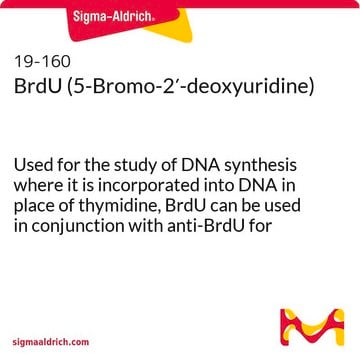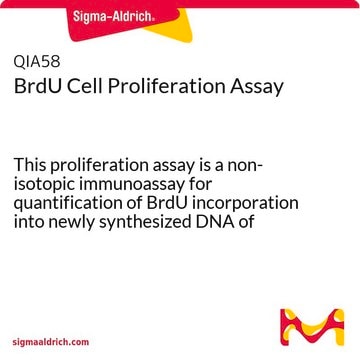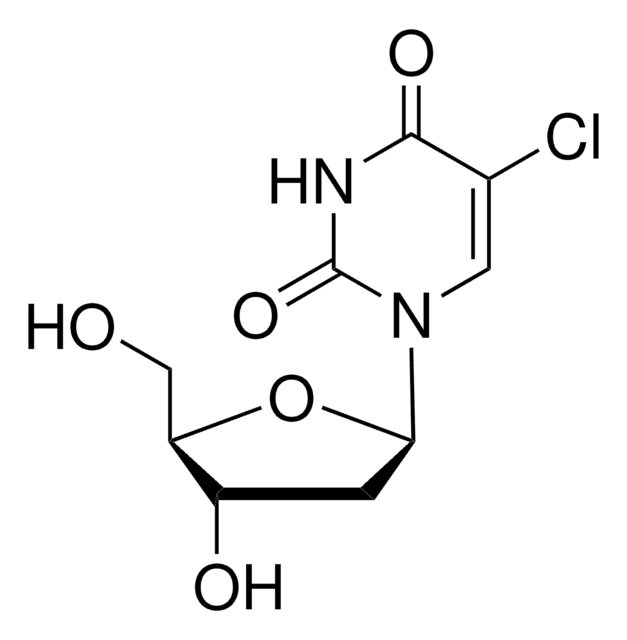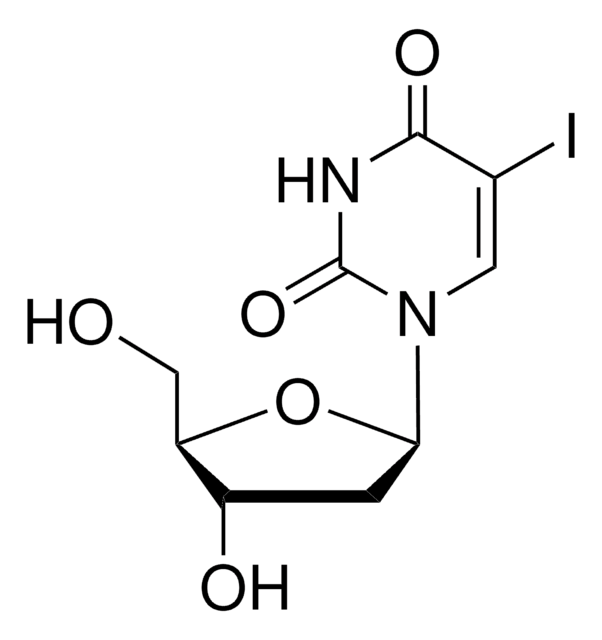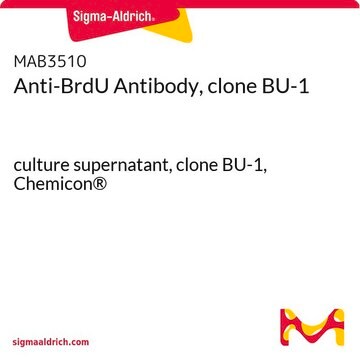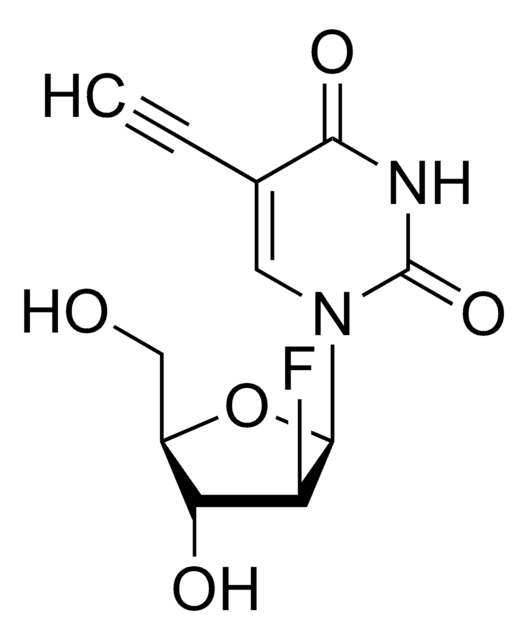5-Bromo-2´-deoxyuridine is stable in solution for 6 months when stored -20°C.
Kluczowe dokumenty
B9285
5-Bromo-2′-deoxyuridine
BioUltra, ≥99%
Synonim(y):
5-BrdU, 5-Bromo-1-(2-deoxy-β-D-ribofuranosyl)uracil, 5-Bromouracil deoxyriboside, BUdR
Wybierz wielkość
200,00 zł
Wybierz wielkość
About This Item
200,00 zł
Polecane produkty
pochodzenie biologiczne
synthetic (organic)
Poziom jakości
linia produktu
BioUltra
Próba
≥99%
Formularz
powder
zanieczyszczenia
≤0.005% Phosphorus (P)
≤0.1% Insoluble matter
pozostałość po prażeniu
≤0.1%
mp
191-194 °C (dec.) (lit.)
rozpuszczalność
NH4OH: 0.1 M at 20 °C, clear, colorless
ślady kationów
Al: ≤0.0005%
Ca: ≤0.01%
Cu: ≤0.0005%
Fe: ≤0.0005%
K: ≤0.005%
Mg: ≤0.0005%
NH4+: ≤0.05%
Na: ≤0.05%
Pb: ≤0.001%
Zn: ≤0.0005%
temp. przechowywania
−20°C
ciąg SMILES
OC[C@H]1O[C@H](C[C@@H]1O)N2C=C(Br)C(=O)NC2=O
InChI
1S/C9H11BrN2O5/c10-4-2-12(9(16)11-8(4)15)7-1-5(14)6(3-13)17-7/h2,5-7,13-14H,1,3H2,(H,11,15,16)/t5-,6+,7+/m0/s1
Klucz InChI
WOVKYSAHUYNSMH-RRKCRQDMSA-N
Szukasz podobnych produktów? Odwiedź Przewodnik dotyczący porównywania produktów
Opis ogólny
Zastosowanie
- to label proliferating cells in pregnant mice in cell proliferation assay[2]
- to study the time course of cell proliferation at various times following ischemia[3], to confirm re-entry of MKI67+ cells in cell cycle to germ cells[4]
- in 5′-Bromo-2′Deoxyuridine (BrdUrd) staining of fibroblasts[5]
Działania biochem./fizjol.
Hasło ostrzegawcze
Danger
Zwroty wskazujące rodzaj zagrożenia
Zwroty wskazujące środki ostrożności
Klasyfikacja zagrożeń
Muta. 1B - Repr. 2
Kod klasy składowania
6.1C - Combustible acute toxic Cat.3 / toxic compounds or compounds which causing chronic effects
Klasa zagrożenia wodnego (WGK)
WGK 2
Środki ochrony indywidualnej
Eyeshields, Gloves, type N95 (US)
Wybierz jedną z najnowszych wersji:
Masz już ten produkt?
Dokumenty związane z niedawno zakupionymi produktami zostały zamieszczone w Bibliotece dokumentów.
Klienci oglądali również te produkty
-
For how long is Product B9285, 5-Bromo-2´-deoxyuridine, stable in solution?
1 answer-
Helpful?
-
-
What is the Department of Transportation shipping information for this product?
1 answer-
Transportation information can be found in Section 14 of the product's (M)SDS.To access the shipping information for this material, use the link on the product detail page for the product.
Helpful?
-
-
In what solvents is Product B9285, 5-Bromo-2´-deoxyuridine, soluble?
1 answer-
Solubility information for 5-bromo-2´-deoxyuridine can be found on the product information sheet (under Documents, above).
Helpful?
-
-
What is the shelf life of Product No. B9285 (5-bromo-2´-deoxyuridine)?
1 answer-
Sigma-Aldrich does not assign an expiration date to this product; it is guaranteed for one year from the date of shipment.
Helpful?
-
-
Can Product B9285, 5-Bromo-2´-deoxyuridine, be injected into animals?
1 answer-
Sigma has not injected animals with solutions of this compound, so we do not have a stepwise procedure for you. However, this application has been reported in the literature. Please see the cited references below, which you may find useful. Several references cite the use of Product No. B9285 in their protocols.1. Yin, X-X, et al., Expression of active caspase-3 in mitotic and postmitotic cells of the rat forebrain. J. Comp. Neurol., 433(1), 4-22 (2001). Injected into mice at 50 mg/kg.2. Dackor, R.T., et al., Hydrops Fetalis, Cardiovascular Defects, and Embryonic Lethality in Mice Lacking the Calcitonin Receptor-Like Receptor Gene. Mol. Cell. Biol., 26(7), 2511-2518 (2006). Injected into mice at 100 mg/kg.3. Farris, S.M., et al., Larval and Pupal Development of the Mushroom Bodies in the Honey Bee, Apis mellifera. J. Comp. Neurol., 414, 97-113 (1999). A 25 mg/mL solution was injected into bee larvae, prepupae, and pupae.4. Gaiano, N., et al., Radial Glial Identity Is Promoted by Notch1 Signaling in the Murine Forebrain. Neuron, 26(2), 395-404 (2000). A 20 mg/mL solution was injected into mice.
Helpful?
-
Active Filters
Nasz zespół naukowców ma doświadczenie we wszystkich obszarach badań, w tym w naukach przyrodniczych, materiałoznawstwie, syntezie chemicznej, chromatografii, analityce i wielu innych dziedzinach.
Skontaktuj się z zespołem ds. pomocy technicznej
